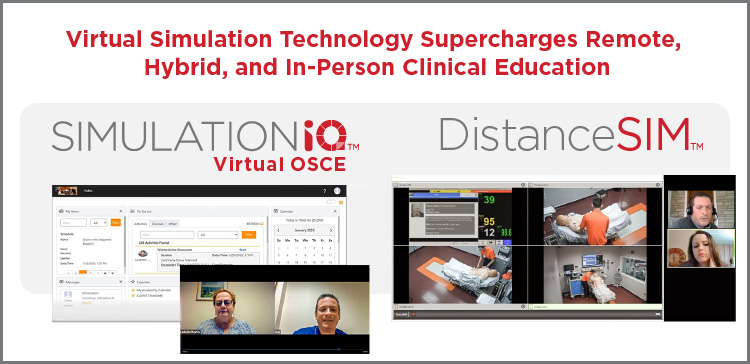Wondering how your program can meet its immediate clinical and simulation-based training needs while maximizing return on investment (ROI) in virtual and distance learning tools? Read on to discover how you can deliver live, virtual simulation scenarios and OSCE encounters—anytime, anywhere.
As we enter the new year, the simulation community is dedicated to maintaining focus on our critical mission: to continue to successfully provide best-in-class training and educational opportunities for tomorrow’s healthcare professionals while modifying existing and developing new course content that meets the educational needs of today – and tomorrow – no matter where the learning takes place.
This means utilizing cutting edge technology that enhances your combined, adaptable in-person, virtual and video-based, and hybrid learning initiatives.
Mandated shutdowns and campus closures driven by COVID-19 left higher education institutions struggling to rapidly pivot their programs between in-person and remote learning environments. For clinical education programs, this meant taking simulation – including simulation scenarios, observations and assessments, accrual of requisite clinical examination hours, and boards and high stakes exams such as the Objective Structured Clinical Examination (OSCE) – online for distance learning.
But virtual learning technology can help programs meet their immediate clinical training needs, no matter where the learning takes place.
Whether you’re educating remotely, in the field, or on campus, the SIMULATIONiQ™ Virtual OSCE platform makes it possible to simply and easily conduct high-impact standardized patient (SP) encounters in an online environment, and meets the critical requirement for students to practice providing clinical treatment in telemedicine formats.
And if you need to leverage your simulation center to substitute clinical observation hours with simulation hours to help ensure your medical, nursing, or allied health learners graduate on time, the DistanceSIM™ Virtual Simulation platform is there to support you.
Combine physical training rooms and virtual teleconferencing connectivity to conduct live simulation and clinical observation scenarios online, and seamlessly tap into your existing AV infrastructure and virtually extend clinical simulation and observation opportunities across your entire learner base. Instructors can also run scenarios from physical simulation rooms and broadcast to remote learners for observation, or act as a proxy for the learner to virtually direct them through the scenario using built-in teleconferencing tools and a distance learning-friendly interface.
Most importantly, virtual simulation technology helps you complete your high impact simulation based training and clinical exams online, without missing a beat. It also facilitates fully remote education environments; supports secure single sign-on and cloud hosting to protect student data, even in fully virtual live environments; and enhances education with live, video-based training, and complete evaluation support.
To better understand how this technology has a powerful, immediate impact on educational delivery and clinical learning outcomes, take the example of McMaster University’s Michael G. DeGrotte School of Medicine: due to COVID-19, clinical simulation training across their three campuses came to a standstill, leading the Faculty of Health Sciences to explore alternatives to keep their clinical skills curriculum on track.
After evaluating multiple in-house and external technology options, McMaster University decided to move forward with the unique and turnkey SIMULATIONiQ Virtual OSCE solution from Education Management Solutions (EMS).
All students, instructors, standardized patients (SPs), and facilitators – more than 500 individuals in total – needed to be connected together in a live virtual environment. The SIMULATIONiQ Virtual OSCE platform captured each encounter, tracked evaluations, and recorded all events for additional playback, review, assessment, scoring and debriefing. Security was a key requirement, and the SIMULATIONiQ Virtual OSCE platform, with secure single-sign on access, ensured all student evaluations and encounters remained confidential, even in a fully remote environment.
Ultimately, 1,243 individual case encounters were run in a single day! All 204 students completed six recorded cases, along with four additional cases, supported by 63 SPs and 126 faculty and staff. The system was set up and configured, and all staff received training, in less than two weeks. Since then, McMaster University has continued to deliver high-impact training and assessment to learners.
While COVID-19 has created barriers for instructors delivering live clinical skill simulation-based training and clinical training may never again look like it did before our “new normal,” post-COVID world, virtual simulation technology is an ideal tool for sustainable success. No matter how many SPs and students are involved in your program, or what your short and long-term clinical training goals may be, your virtual simulation and virtual OSCE technology supports you with scalable, on-demand clinical training for the delivery of actual care.
Learn more about EMS’ SIMULATIONiQ Virtual OSCE and DistanceSIM technology, and book a free demo today!

